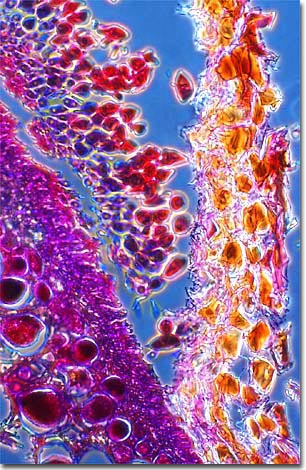Phase Contrast Image Gallery
Cedar Apple Rust
Cedar apple rust (CAR) is a disease affecting apple trees in North America east of the Rocky Mountains. It is caused by the fungus Gymnosporangium juniperi-virginianae and can defoliate trees and blemish fruit making them unmarketable. As evidenced by this micrograph, combining phase contrast microscopy with classical histological staining techniques often yields enhancement of cellular features.

The CAR fungus has a complex life cycle that requires two hosts, eastern red cedar trees and apple or crab apple trees. Throughout its two-year life cycle, the fungus produces three kinds of spores: aeciospores, teliospores, and basidiospores, each with a specific function. Spores produced on the apple trees do not infect other apple trees. Only the spores produced on cedar trees can infect apple trees. Likewise, only the spores from apples can infect cedar trees.
During the summer, infected apple trees produce aeciospores on the undersides of leaves and on fruits. These spores become airborne and infect cedar trees. Once they arrive on the host cedar, the spores germinate and become galls (small, round structures), protecting the fungus over the winter months. During spring rains in the second year after infection, a structure emerges from the gall that produces teliospores. The teliospores germinate and, within a matter of hours, produce basidiospores, the spore type that can infect apples. These are forcibly discharged into the air immediately after being formed and can be carried long distances until they land on a host apple tree, continuing the cycle.
BACK TO THE PHASE CONTRAST GALLERY
